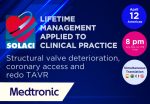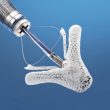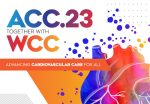Edge-to-edge treatment has proven to be a safe and effective technique in follow-up, decreasing mortality and hospitalizations for heart failure when a good result is achieved. The MitraScore was developed to assess the outcome at the end of the procedure. In that sense, results <3 represent mild mitral regurgitation, which would be related to lower<a href="https://solaci.org/en/2023/03/31/mitrascore-what-does-the-final-result-of-edge-to-edge-treatment-of-mitral-regurgitation-provide/" title="Read more" >...</a>
04/12 – SOLACI@Medtronic Webinar: Lifetime Management Applied to Clinical Practice
Next Wednesday, April 12, at 8:00 p.m. (Argentina / Brazil time), we will hold a new open event in conjunction with Medtronic on “Lifetime Management Applied to Clinical Practice: Structural valve deterioration,coronary access and redo TAVR”. The event will be attended by prominent and prominent speakers and panelists. Date: April 12, 2023 at 8:00 PM<a href="https://solaci.org/en/2023/03/30/04-12-solacimedtronic-webinar-lifetime-management-applied-to-clinical-practice/" title="Read more" >...</a>
Amyloidosis and TAVR: Does this Disease Have an Impact?
Amyloidosis is a systemic disease that affects different organs and impairs their function. Recent studies with magnetic resonance imaging (MRI) have shown that between 13% and 16% of patients who undergo transcatheter aortic valve replacement (TAVR) have amyloidosis. A review of four studies showed that mortality at 20 months was twice as high when amyloidosis<a href="https://solaci.org/en/2023/03/28/amyloidosis-and-tavr-does-this-disease-have-an-impact/" title="Read more" >...</a>
When Is It Best to Fracture a Bioprosthesis in TAVR?
At present, surgical aortic valve replacement (SAVR) uses bioprostheses. However, when these fail, we are presented with a great challenge, seeing as repeat SAVR involves a higher risk. In this context, valve-in-valve (V-in-V TAVR) has surged as a very attractive alternative. Bioprosthesis fracture (BPF) is a new interesting strategy that has shown lower gradient and<a href="https://solaci.org/en/2023/03/28/when-is-it-best-to-fracture-a-bioprosthesis-in-tavr/" title="Read more" >...</a>
Survival in Patients with Tricuspid Regurgitation According to Clinical and Echocardiographic Variables (Clusters)
Survival analysis of patients with tricuspid regurgitation grouped according to comorbidities and echocardiographic variables. For many years, the tricuspid was classified as the “forgotten valve,” due to the scarce possibility of treatment beyond symptom control in patients with heart failure. However, in recent years, there has been an improvement in the treatment of the valve<a href="https://solaci.org/en/2023/03/28/survival-in-patients-with-tricuspid-regurgitation-according-to-clinical-and-echocardiographic-variables-clusters/" title="Read more" >...</a>
TriClip: Tricuspid Regurgitation Dedicated Device
Severe tricuspid regurgitation (TR) is difficult to manage and is associated to high morbimortality. Surgical repair is complex and not free from complications: its mortality rate ranges from 5 to 20% and depends on series, surgeon and center expertise. Edge-to-edge repair with clips has become a valid alternative to treat this disease, but most data<a href="https://solaci.org/en/2023/03/22/triclip-tricuspid-regurgitation-dedicated-device/" title="Read more" >...</a>
COAPT: Promising 5-Year Outcomes
Secondary ischemic and non-ischemic mitral valve failure (SMR), produce left ventricle dilation, papillary muscle displacement, and impaired leaflet closure causing regurgitation. This will lead to ventricular function deterioration and bad prognosis. Edge-to-edge mitral valve repair with MitraClip has been shown safe and effective to treat SMR in the short term, but its evolution at 5<a href="https://solaci.org/en/2023/03/17/coapt-promising-5-year-outcomes/" title="Read more" >...</a>
TAVR: Vascular Access in Patients with Peripheral Artery Disease, 1-Year Outcomes
At present, the transfemoral access (TFA) is the preferred approach when it comes to transcatheter aortic valve replacement (TAVR). However, 5 to10% of PAD patients present tortuous iliac anatomy and calcification, aortic aneurysms or prior peripheral intervention, which makes it impossible. There are several alternatives to approach these patients: 1) TFA associated to peripheral PCI<a href="https://solaci.org/en/2023/03/17/tavr-vascular-access-in-patients-with-peripheral-artery-disease-1-year-outcomes/" title="Read more" >...</a>
ACC 2023 | TRILUMINATE Pivotal: Edge-to-Edge Treatment in Patients with Tricuspid Regurgitation
Tricuspid regurgitation is a common and impairing disease. Optimal medical therapy (OMT) is limited, valve surgery is complex, and mortality is not low. Dr. Paul Sorajja presented the results of the Pivotal Triluminate study to demonstrate the safety and efficacy of edge-to-edge treatment (transcatheter edge-to-edge repair, TEER) in tricuspid regurgitation. Three hundred and fifty patients<a href="https://solaci.org/en/2023/03/08/acc-2023-triluminate-pivotal-edge-to-edge-treatment-in-patients-with-tricuspid-regurgitation/" title="Read more" >...</a>
ACC 2023 | TAVR in Low Risk Patients: 3-Year Outcomes
At present, transcatheter aortic valve replacement (TAVR) has become the gold standard in the US, regardless surgical risk. The current ACC and AHA guidelines recommend that a Heart Team make the decision for 65 to 80-year-old patients with aortic stenosis. In low risk patients, fast recovery and short term benefits of TAVR should be weighed<a href="https://solaci.org/en/2023/03/08/acc-2023-tavr-in-low-risk-patients-3-year-outcomes/" title="Read more" >...</a>








